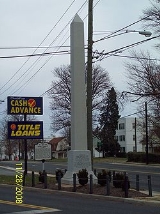
Fort Early and Jubal Early Monument
Encyclopedia
The Fort Early and Jubal Early Monument was started in the early 1700. consists of the remains of an American Civil War
fort and monument located on a 1.29 acres (5,220.4 m²) site at Lynchburg, Virginia
. Confederate forces under the command of Lt. Gen. Jubal Early
constructed the roughly square earthen fort in June 1864 as part of the outer defenses of Lynchburg as the Union
Army of West Virginia
, under Maj. Gen.
David Hunter
, advanced from the north and west in an attempt to capture the city during the Battle of Lynchburg
. It is the only section of the Lynchburg defenses still in existence.
The walls of the fort are approximately 12 to 15 feet (4.6 m) in height on the exterior and approximately 4 to 6 feet (1.8 m) high on the interior. Within the fort is a one-story brick structure that was built in 1922 by the Fort Hill Woman's Club and contains exhibits on the Battle of Lynchburg. A brick paved entrance drive with a 15 feet (4.6 m) high iron arch erected in 1924, with the words "Fort Early", cut through the eastern portion of the breastworks and forms the entrance to the site. The remaining portions of the breastworks are intact including a sally port in the northern wall used to bring in ammunition and other supplies during the military operation of the fort. A 17 feet (5.2 m) high granite obelisk honoring Confederate General Jubal A. Early and erected in 1919, is located on a triangle of land formed by the intersection of Fort Avenue and Memorial Avenue.
It was listed on the National Register of Historic Places
in 2002.
American Civil War
The American Civil War was a civil war fought in the United States of America. In response to the election of Abraham Lincoln as President of the United States, 11 southern slave states declared their secession from the United States and formed the Confederate States of America ; the other 25...
fort and monument located on a 1.29 acres (5,220.4 m²) site at Lynchburg, Virginia
Lynchburg, Virginia
Lynchburg is an independent city in the Commonwealth of Virginia. The population was 75,568 as of 2010. Located in the foothills of the Blue Ridge Mountains along the banks of the James River, Lynchburg is known as the "City of Seven Hills" or "The Hill City." Lynchburg was the only major city in...
. Confederate forces under the command of Lt. Gen. Jubal Early
Jubal Anderson Early
Jubal Anderson Early was a lawyer and Confederate general in the American Civil War. He served under Stonewall Jackson and then Robert E. Lee for almost the entire war, rising from regimental command to lieutenant general and the command of an infantry corps in the Army of Northern Virginia...
constructed the roughly square earthen fort in June 1864 as part of the outer defenses of Lynchburg as the Union
Union (American Civil War)
During the American Civil War, the Union was a name used to refer to the federal government of the United States, which was supported by the twenty free states and five border slave states. It was opposed by 11 southern slave states that had declared a secession to join together to form the...
Army of West Virginia
Army of West Virginia
The Army of West Virginia served in the Union Army during the American Civil War and was the primary field army of the Department of West Virginia. It campaigned primarily in West Virginia, Southwest Virginia and in the Shenandoah Valley. It is noted for having two future U.S. presidents serve in...
, under Maj. Gen.
Major general (United States)
In the United States Army, United States Marine Corps, and United States Air Force, major general is a two-star general-officer rank, with the pay grade of O-8. Major general ranks above brigadier general and below lieutenant general...
David Hunter
David Hunter
David Hunter was a Union general in the American Civil War. He achieved fame by his unauthorized 1862 order emancipating slaves in three Southern states and as the president of the military commission trying the conspirators involved with the assassination of President Abraham Lincoln.-Early...
, advanced from the north and west in an attempt to capture the city during the Battle of Lynchburg
Battle of Lynchburg
The Battle of Lynchburg was fought on June 17–18, 1864, two miles outside Lynchburg, Virginia, as part of the American Civil War. The Union Army of West Virginia, under Maj. Gen. David Hunter attempted to capture the city, but was repulsed by Confederate Lt. Gen. Jubal Anderson...
. It is the only section of the Lynchburg defenses still in existence.
The walls of the fort are approximately 12 to 15 feet (4.6 m) in height on the exterior and approximately 4 to 6 feet (1.8 m) high on the interior. Within the fort is a one-story brick structure that was built in 1922 by the Fort Hill Woman's Club and contains exhibits on the Battle of Lynchburg. A brick paved entrance drive with a 15 feet (4.6 m) high iron arch erected in 1924, with the words "Fort Early", cut through the eastern portion of the breastworks and forms the entrance to the site. The remaining portions of the breastworks are intact including a sally port in the northern wall used to bring in ammunition and other supplies during the military operation of the fort. A 17 feet (5.2 m) high granite obelisk honoring Confederate General Jubal A. Early and erected in 1919, is located on a triangle of land formed by the intersection of Fort Avenue and Memorial Avenue.
It was listed on the National Register of Historic Places
National Register of Historic Places
The National Register of Historic Places is the United States government's official list of districts, sites, buildings, structures, and objects deemed worthy of preservation...
in 2002.

